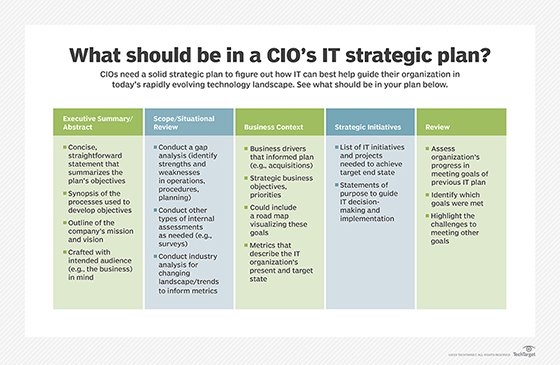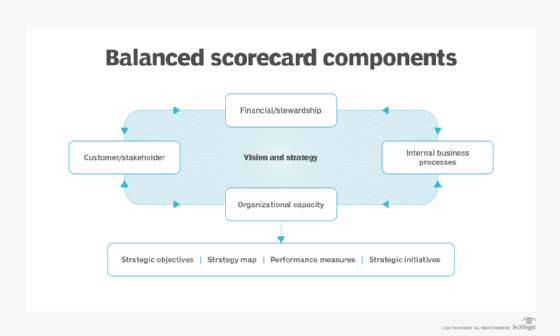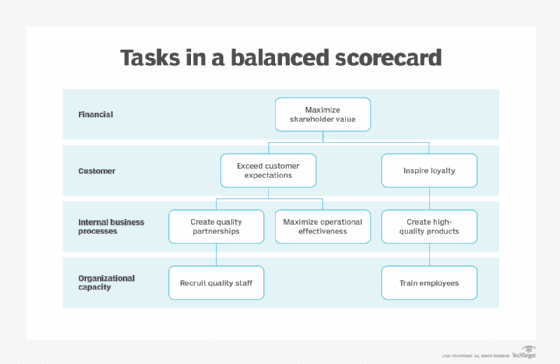the Art of the Possible Applies to Which Step of the Strategic Planning
What is strategic planning?
Strategic planning is a procedure in which an organisation's leaders define their vision for the future and identify their system'south goals and objectives. The process includes establishing the sequence in which those goals should exist realized so that the system tin can reach its stated vision.
Strategic planning typically represents mid- to long-term goals with a life bridge of three to five years, though it tin get longer. This is different than concern planning, which typically focuses on short-term, tactical goals, such as how a budget is divided up. The time covered by a business concern plan can range from several months to several years.
The product of strategic planning is a strategic plan. It is frequently reflected in a plan document or other media. These plans can be easily shared, understood and followed past various people including employees, customers, business partners and investors.
Organizations conduct strategic planning periodically to consider the effect of changing business, industry, legal and regulatory conditions. A strategic programme may exist updated and revised at that fourth dimension to reverberate any strategic changes.

Why is strategic planning important?
Businesses need direction and organizational goals to work toward. Strategic planning offers that type of guidance. Substantially, a strategic program is a roadmap to go to business organization goals. Without such guidance, in that location is no way to tell whether a business concern is on runway to reach its goals.
The following iv aspects of strategy development are worth attention:
- The mission. Strategic planning starts with a mission that offers a company a sense of purpose and direction. The organization's mission statement describes who it is, what it does and where it wants to go. Missions are typically broad but actionable. For example, a business in the teaching industry might seek to be a leader in online virtual educational tools and services.
- The goals. Strategic planning involves selecting goals. Most planning uses SMART goals -- specific, measurable, achievable, realistic and time-bound -- or other objectively measurable goals. Measurable goals are important considering they enable business leaders to determine how well the business organization is performing against goals and the overall mission. Goal setting for the fictitious educational business might include releasing the first version of a virtual classroom platform inside two years or increasing sales of an existing tool by 30% in the adjacent year.
- Alignment with short-term goals. Strategic planning relates directly to brusque-term, tactical business planning and can help business leaders with everyday controlling that ameliorate aligns with business organization strategy. For the fictitious educational business organization, leaders might choose to make strategic investments in communication and collaboration technologies, such as virtual classroom software and services only refuse opportunities to establish physical classroom facilities.
- Evaluation and revision. Strategic planning helps business leaders periodically evaluate progress against the plan and make changes or adjustments in response to changing conditions. For example, a business concern may seek a global presence, merely legal and regulatory restrictions could emerge that impact its ability to operate in sure geographic regions. Every bit consequence, business leaders might take to revise the strategic plan to redefine objectives or change progress metrics.
What are the steps in the strategic planning process?
At that place are myriad different means to approach strategic planning depending on the type of business and the granularity required. Most strategic planning cycles can be summarized in these five steps:
Identify. A strategic planning wheel starts with the determination of a business'southward current strategic position. This is where stakeholders utilise the existing strategic plan -- including the mission statement and long-term strategic goals -- to perform assessments of the business and its environment. These assessments can include a needs assessment or a SWOT (strengths, weaknesses, opportunities and threats) analysis to empathise the land of the business and the path ahead.
Prioritize. Next, strategic planners prepare objectives and initiatives that line up with the company mission and goals and will motility the business concern toward achieving its goals. There may exist many potential goals, so planning prioritizes the most important, relevant and urgent ones. Goals may include a consideration of resource requirements -- such as budgets and equipment -- and they oft involve a timeline and business metrics or KPIs for measuring progress.
Develop. This is the chief thrust of strategic planning in which stakeholders collaborate to formulate the steps or tactics necessary to accomplish a stated strategic objective. This may involve creating numerous curt-term tactical business concern plans that fit into the overarching strategy. Stakeholders involved in programme development use diverse tools such as a strategy map to help visualize and tweak the plan. Developing the plan may involve price and opportunity tradeoffs that reverberate business concern priorities. Developers may reject some initiatives if they don't support the long-term strategy.
Implement. In one case the strategic plan is adult, it'due south time to put it in motility. This requires clear communication across the organisation to ready responsibilities, brand investments, adapt policies and processes, and establish measurement and reporting. Implementation typically includes strategic management with regular strategic reviews to ensure that plans stay on track.
Update. A strategic programme is periodically reviewed and revised to conform priorities and reevaluate goals as business conditions modify and new opportunities emerge. Quick reviews of metrics can happen quarterly, and adjustments to the strategic program tin can occur annually. Stakeholders may use balanced scorecards and other tools to appraise performance confronting goals.

Who does the strategic planning in a business?
A committee typically leads the strategic planning process. Planning experts recommend the commission include representatives from all areas within the enterprise and work in an open and transparent way where information is documented from commencement to finish.
The committee researches and gathers the information needed to understand the organization's current status and factors that will affect it in the future. The committee should solicit input and feedback to validate or claiming its assessment of the data.
The committee can opt to use 1 of many methodologies or strategic frameworks that have been developed to guide leaders through this procedure. These methodologies take the committee through a serial of steps that include an assay or cess, strategy conception, and the articulation and advice of the deportment needed to move the organization toward its strategic vision.
The committee creates benchmarks that will enable the organization to determine how well information technology is performing confronting its goals equally it implements the strategic plan. The planning process should also identify which executives are accountable for ensuring that benchmarking activities take place at planned times and that specific objectives are met.
How often should strategic planning be washed?
There are no uniform requirements to dictate the frequency of a strategic planning bike. Notwithstanding, there are common approaches.
- Quarterly reviews. One time a quarter is usually a convenient time frame to revisit assumptions made in the planning process and gauge progress by checking metrics against the programme.
- Annual reviews. A yearly review lets business organization leaders assess metrics for the previous 4 quarters and make informed adjustments to the plan.
Timetables are always subject to change. Timing should be flexible and tailored to the needs of a company. For example, a startup in a dynamic industry might revisit its strategic plan monthly. A mature business in a well-established industry might opt to revisit the program less frequently.
Types of strategic plans
Strategic planning activities typically focus on three areas: business, corporate or functional. They pause out as follows:
- Business. A business-centric strategic plan focuses on the competitive aspects of the organization -- creating competitive advantages and opportunities for growth. These plans adopt a mission evaluating the external business concern environment, setting goals, and allocating financial, human and technological resource to meet those goals. This is the typical strategic plan and the chief focus of this article.
- Corporate. A corporate-centric plan defines how the company works. It focuses on organizing and aligning the structure of the concern, its policies and processes and its senior leadership to meet desired goals. For example, the management of a research and development skunkworks might be structured to role dynamically and on an advert hoc basis. It would look unlike from the management team in finance or Hour.
- Functional. Function-centric strategic plans fit within corporate-level strategies and provide a granular exam of specific departments or segments such as marketing, 60 minutes, finance and development. Functional plans focus on policy and procedure -- such as security and compliance -- while setting budgets and resource allocations.
In most cases, a strategic plan volition involve elements of all three focus areas. Merely the programme may lean toward one focus expanse depending on the needs and blazon of business
What is strategic management?
Organizations that are best at aligning their actions with their strategic plans engage in strategic management. A strategic management process establishes ongoing practices to ensure that an organization'south processes and resources support the strategic programme'south mission and vision statement.
In uncomplicated terms, strategic direction is the implementation of the strategy. Equally such, strategic management is sometimes referred to as strategy execution. Strategy execution involves identifying benchmarks, allocating fiscal and human resource and providing leadership to realize established goals.
Strategic management may involve a prescriptive or descriptive approach. A prescriptive arroyo focuses on how strategies should be created. It oft uses an analytical arroyo -- such as SWOT or balanced scorecards -- to account for risks and opportunities. A descriptive arroyo focuses on how strategies should exist implemented and typically relies on general guidelines or principles.
Given the similarities between strategic planning and strategic management, the two terms are sometimes used interchangeably.
What is a strategy map?
A strategy map is a planning tool or template used to help stakeholders visualize the complete strategy of a business as one interrelated graphic. These visualizations offer a powerful fashion for understanding and reviewing the crusade-and-effect relationships amid the elements of a business organization strategy.
While a map can be drawn in a number of means, all strategy maps focus on iv major business areas or categories: financial, customer, internal business concern processes (IBPs), and learning and growth. Goals sort into those 4 areas, and relationships or dependencies among those goals can exist established.
For instance, a strategy map might include a financial goal of reducing costs and an IBP goal to meliorate operational efficiency. These two goals are related and can help stakeholders understand that tasks such equally improving operational workflows can reduce company costs and meet two elements of the strategic plan.
A strategy map tin can help translate overarching goals into an action plan and goals that tin can be aligned and implemented.
Strategy mapping can too aid to identify strategic challenges that might not be obvious. For example, one learning and growth goal may exist to increase employee expertise but that may expose unexpected challenges in employee retention and compensation, which affects toll reduction goals.

Benefits of strategic planning
Effective strategic planning has many benefits. It forces organizations to be aware of the futurity country of opportunities and challenges. Information technology also forces them to conceptualize risks and sympathize what resource volition be needed to seize opportunities and overcome strategic issues.
Strategic planning also gives individuals a sense of direction and marshals them around a common mission. It creates standards and accountability. Strategic planning can enhance operational plans and efficiency. It also helps organizations limit time spent on crunch management, where they're reacting to unexpected changes that they failed to anticipate and prepare for.
Information engineering science is a key part of developing an effective strategic plan. Look at these six free IT strategic planning templates that can aid make IT a driving strength in a business.
Source: https://www.techtarget.com/searchcio/definition/strategic-planning
0 Response to "the Art of the Possible Applies to Which Step of the Strategic Planning"
Post a Comment